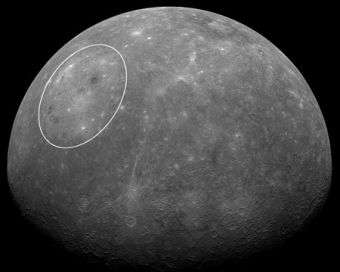Mercury Flyby Sets Stage for New Discoveries

"Discoveries are at hand!" That's what members of the MESSENGER science team are saying after their spacecraft flew past Mercury on Jan. 14th at a distance of only 124 miles. The historic flyby netted 500 megabytes of data (now safely downloaded to Earth) and more than 1200 photos covering nearly six million square miles of previously unseen terrain.
"We're inundated with data—it's wonderful," says mission scientist and planetary geologist Scott Murchie of the Johns Hopkins Applied Physics Lab.
One of the first images beamed back from the spacecraft revealed a side of Mercury researchers have been waiting three decades to see.
The cratered expanse pictured above was mostly in darkness 30 years ago when NASA's Mariner 10 spacecraft made the first and (until now) only flybys of Mercury. Last week, MESSENGER caught the terrain in sunlight for the first time.
At first glance, the photo seems to show little more than a wasteland of craters, but researchers are excited.
"These are fantastic images," says Murchie. For one thing, "we've gotten our first good look at Caloris Basin," the biggest known impact crater on Mercury and one of the biggest craters in the entire solar system.
In the mid-1970s, Mariner 10 caught a tantalizing glimpse of the basin's edge, a ring of shadowed mountains thrown up long ago by some catastrophic impact. A comet or asteroid had smashed Mercury and gouged a crater bigger than the state of Texas. What was inside? No one could say.
"Big impacts are revealing," says Murchie. "They're natural drill holes that expose the interior of the planet—which of course we're dying to see."
MESSENGER snapped the picture that geologists had long wanted: Caloris in its entirety, a top-down view in broad daylight—and the results were surprising. Many experts expected the interior of Caloris Basin to be dark, like the dark 'seas' of hardened lava that fill major impact basins on the Moon and give anthropomorphic form to the "Man in the Moon." Instead, Caloris is bright inside and pitted with regions of interesting color.
Color is something MESSENGER excels at. "Color reveals mineralogy," says Murchie. "Two of the instruments onboard MESSENGER are able to map the surface of Mercury in wavelengths ranging from ultraviolet across the visible spectrum to near-infrared. We're calibrating the data now and plan to release some full-color images soon."
Another early highlight of the flyby are ridges geologists call lobate scarps: photo. These are fractures in Mercury's crust formed, perhaps, as a result of planetary shrinkage. (Think wrinkles on a raisin.) What could cause a rigid, rocky planet to shrink? Billions of years ago, "Mercury may have undergone a period of contraction as its molten core cooled," suggests Murchie. High-resolution MESSENGER photos of Mercury's scarps will allow geologists to test this and other ideas.
Other snapshots of note include a telephone-shaped crater, Mercury's Antarctic, and a "fresh" crater with many secondary crater chains. Browse the gallery for more.
"We're leaving no stone unturned," says Murchie. In all, there are 110+ scientists, students and engineers sifting through the harvest of photography, spectroscopy, laser radar echoes and magnetic field measurements from the Jan. 14th flyby. Discoveries are sure to ensue.
And remember, he says, "this is just the first of three flybys" in preparation for orbit insertion in 2011. The next encounters are scheduled for Oct. 2008 and Sept. 2009. More than a third of Mercury's surface has yet to be photographed and those flybys will fill in many gaps. Meanwhile, researchers are fully occupied.
Source: by Dr. Tony Phillips, Science@NASA





















